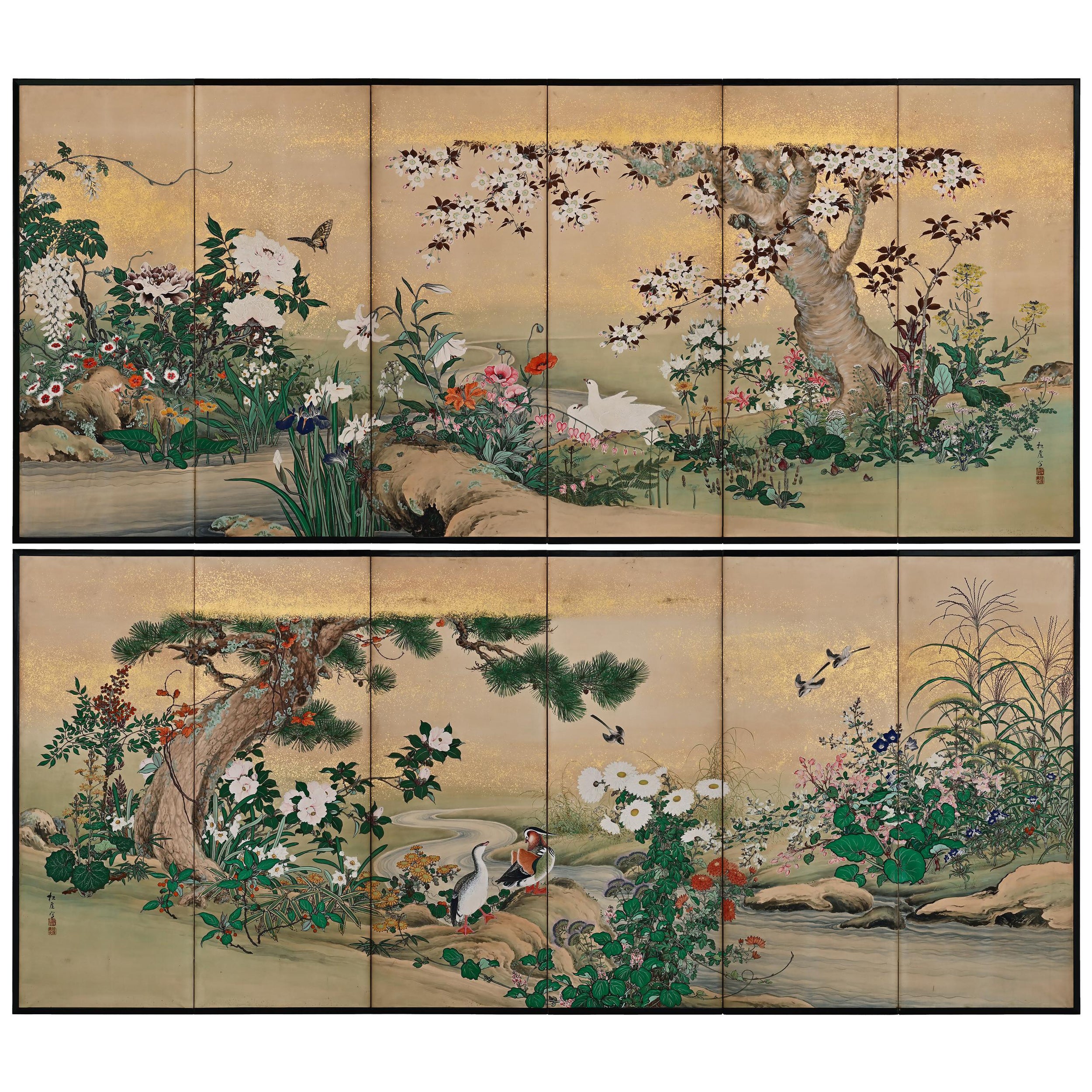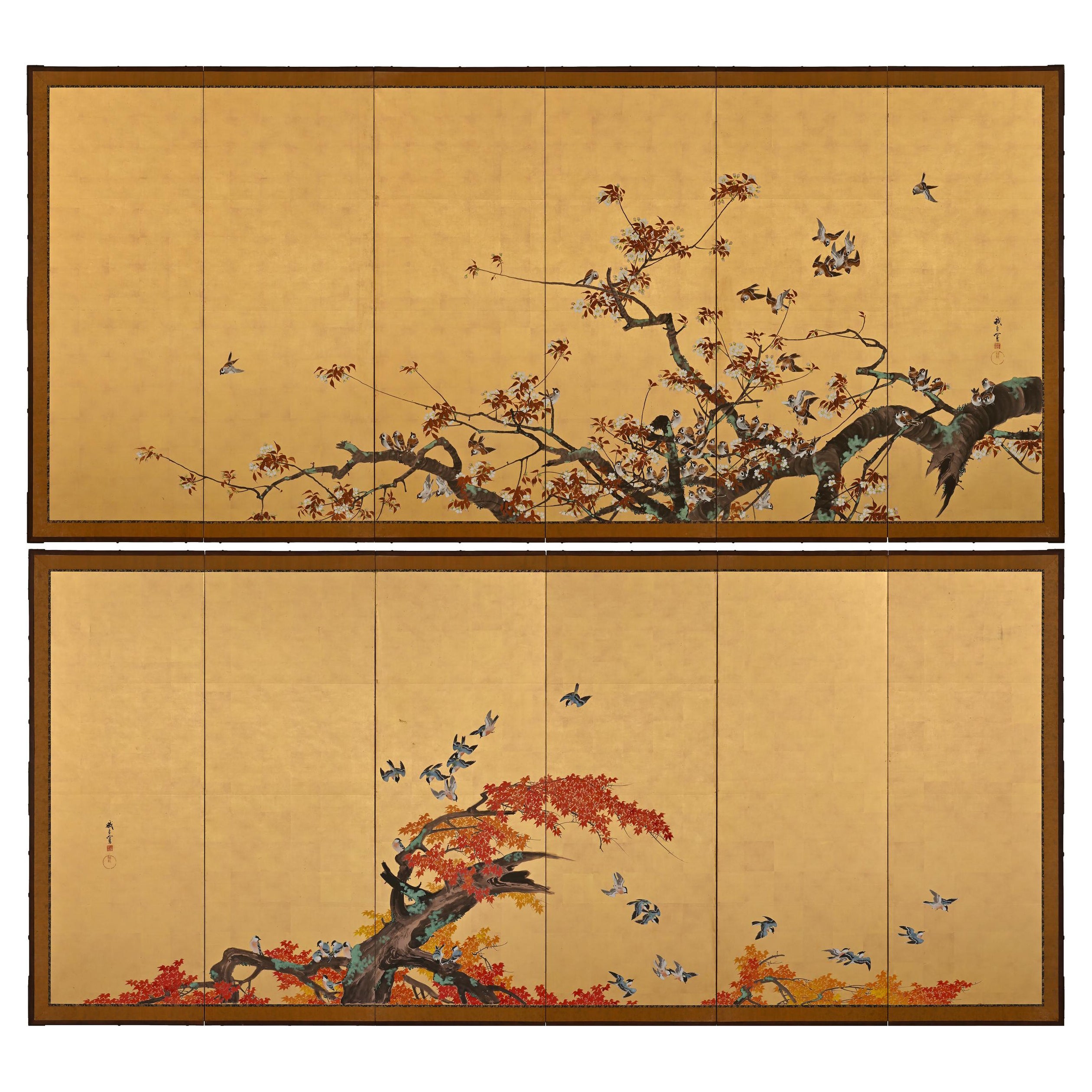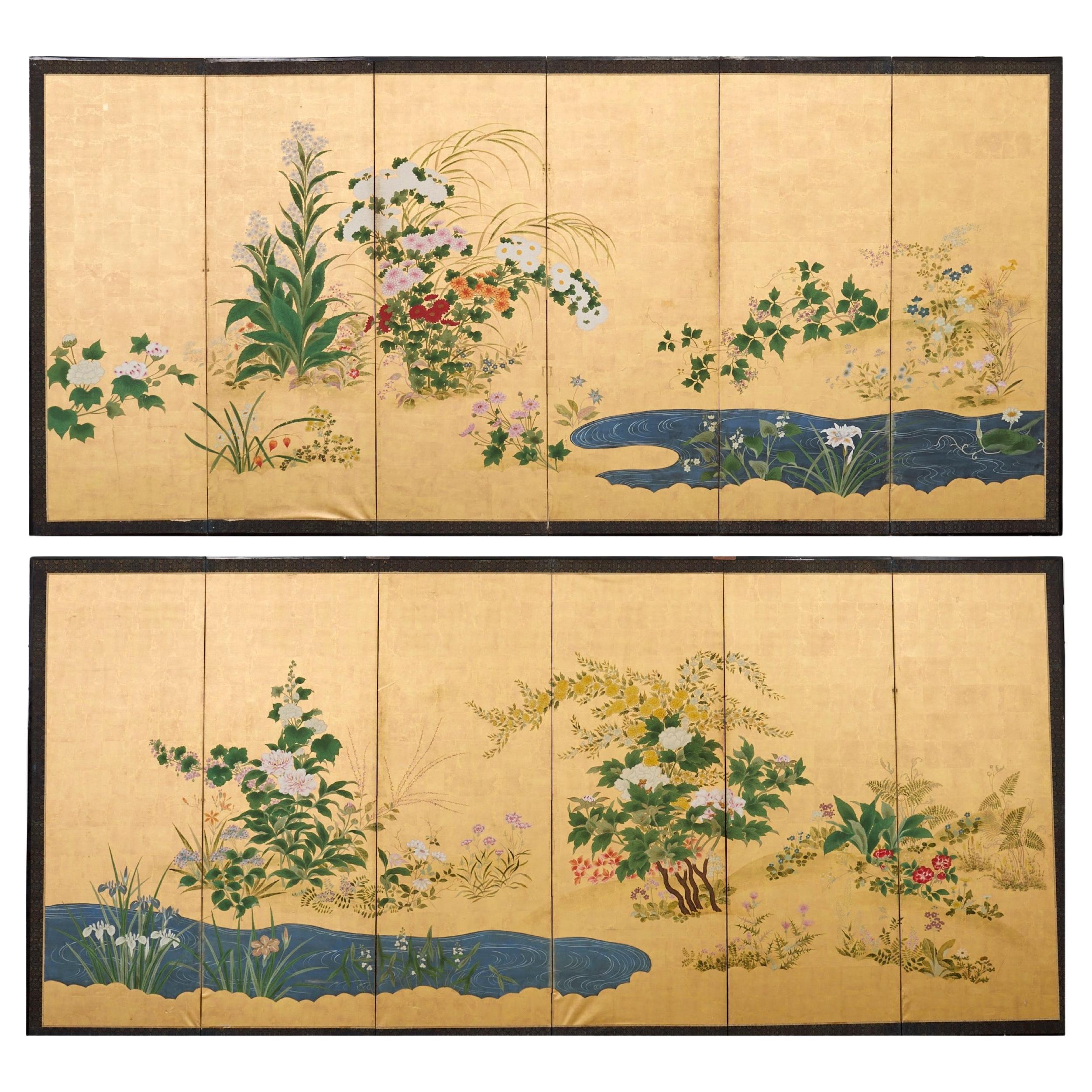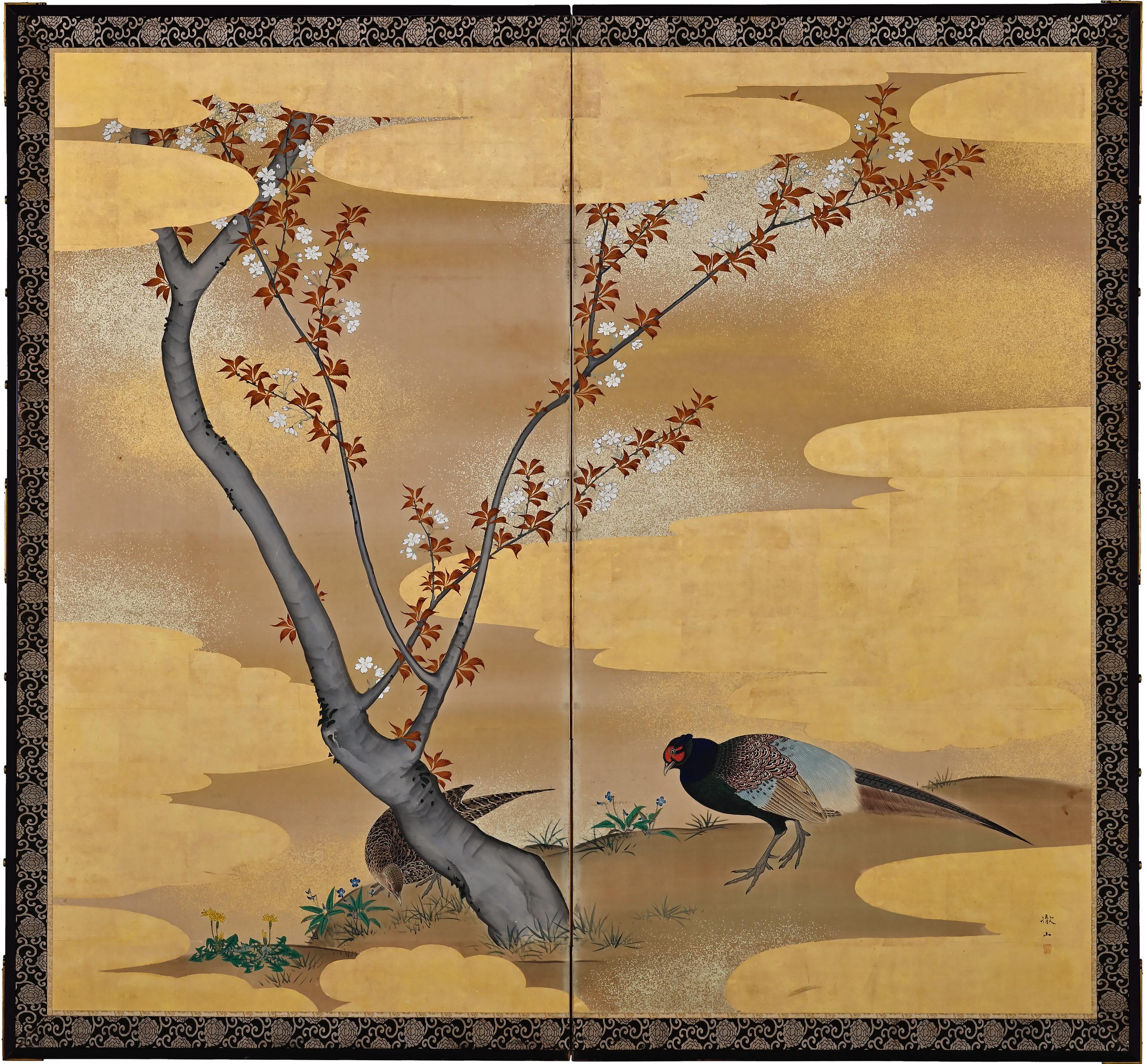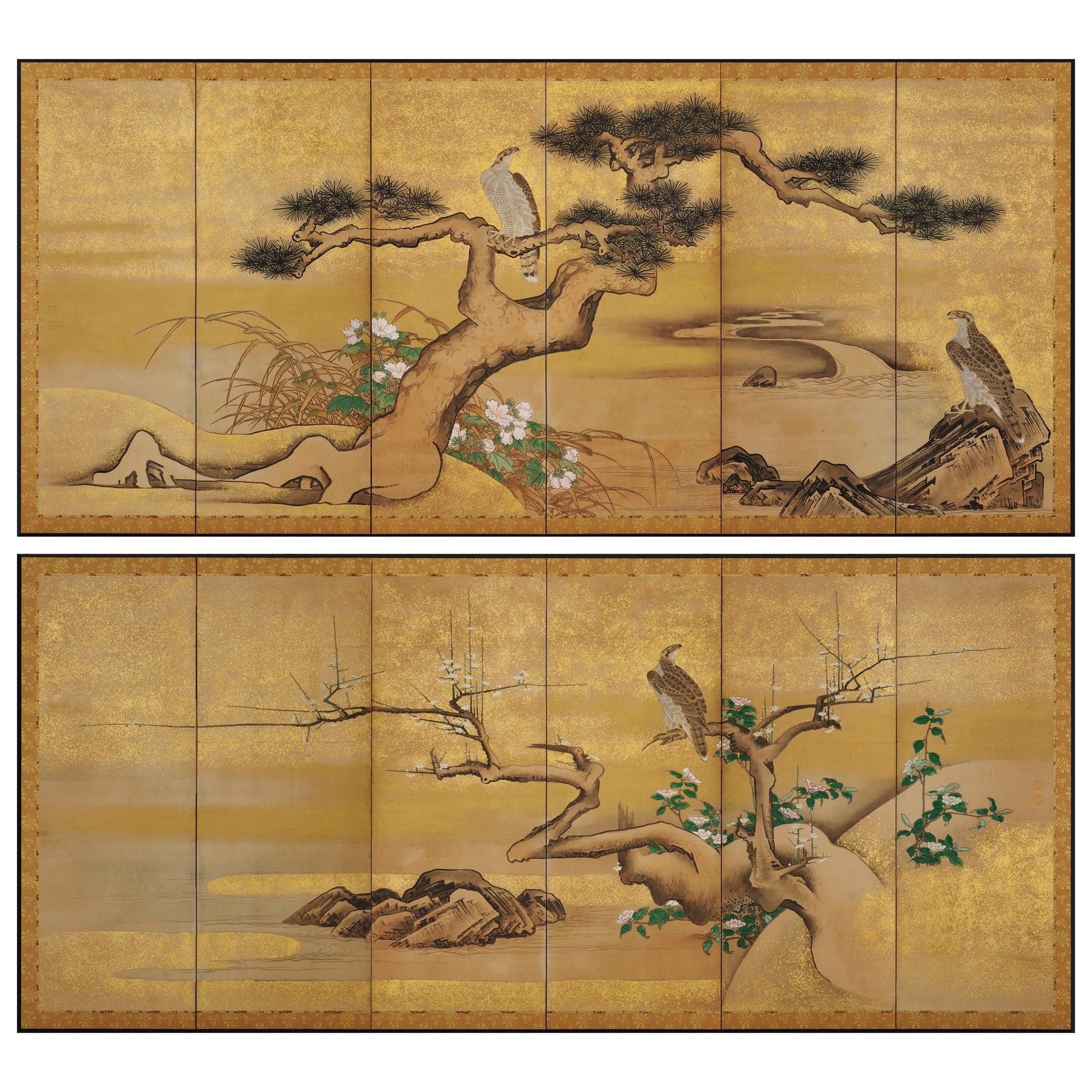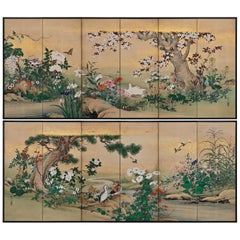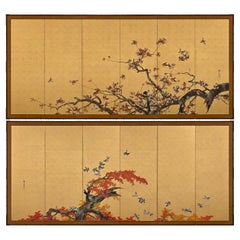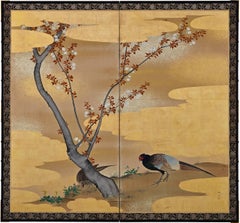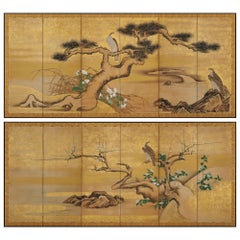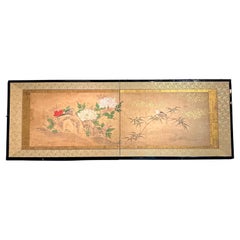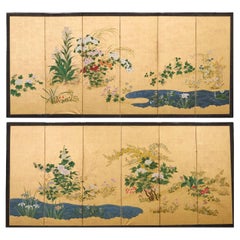Items Similar to Mid 19th Century Japanese Screen Pair. Flowers & Birds of the Four Seasons.
Want more images or videos?
Request additional images or videos from the seller
1 of 14
Mid 19th Century Japanese Screen Pair. Flowers & Birds of the Four Seasons.
$68,000per set
£51,989.62per set
€59,881.54per set
CA$95,288.85per set
A$106,381.04per set
CHF 55,742.07per set
MX$1,302,208.34per set
NOK 707,924.78per set
SEK 667,483.19per set
DKK 446,902.09per set
About the Item
Shioka Sorin (1781-1850)
Flowers & Birds of the Four Seasons
Pair of six-panel Japanese Screens. Ink, gofun and pigments on silk.
Dimensions (each screen): H. 91.5cm x W. 285cm (36” x 112”)
A pair of smaller Japanese six-fold screens by the Nanpin school artist Shioka Sorin (1781-1850). The highly decorative flowers of these Japanese screens evoke the passage of the seasons from Spring through to Winter. Flowering crabapple and peonies denote spring and summer on the right screen. On the left screen ornamental chrysanthemums, maple and hibiscus represent autumn and the red berries at the extreme left lead us in to winter. The white peacocks and Chinese pheasants are depicted for their extraordinary plumage and colors, with the flowers and birds combining to create a brilliant patterned effect. Almost the entire surface of the silk panels are covered in mineral pigments which contributes greatly to the tactile richness of the surface.
Colorful Chinese flower and bird paintings were created by court painters during the Ming dynasty (1368–1644) to decorate the grand halls of imperial palaces, where they could also serve as metaphors for the emperor and his court. However, Japanese artists transformed the courtly Chinese painting tradition into more exquisite, decorative and distinctive 'Japanese' style. From the 17th century on, patrons of the arts came from more than just the ruling classes. As the buying power of the traditional elites of the aristocracy and samurai dwindled, wealth increased among merchants, who were long considered at the bottom of the social scale. The merchant class patronized newly formed groups of artists who better represented their aesthetics and interests. Paintings from the Nanpin school in a naturalistic manner reflected a fascination with the exotic and a burgeoning interest in empirical science. This new style introduced through Nagasaki spread to the art world in Kamigata (Kyōto and Ōsaka) and Edo, giving rise to a new style of painting which had a significant impact on the future direction of Japanese art. Their work, mostly of flower and bird subjects, derives from a blend of realism with a brightly colored decorative manner. The Chinese artist Shen Nanpin (Shen Quan) is credited as being the originator of the style, arriving in Japan in 1731. He was a relatively unknown painter of the Ming academic style though quickly gained great fame in Japan.
Shiokawa Sorin (1781-1850) was the son of So Shizan (1733-1805) and the grandson of So Shiseki (1715-1786). A native of Edo, he inherited and continued the family painting traditions and passed on their Nanpin style. His grandfather, So Shiseki, was a very influential artist in Japanese painting history. He took the Nanpin school beyond its origins in Nagasaki and beyond its basis in bird and flower subjects. Among his most famous students were Shiba Kokan and Sakai Hoitsu.
- Dimensions:Height: 36 in (91.44 cm)Width: 112 in (284.48 cm)Depth: 0.75 in (1.91 cm)
- Sold As:Set of 2
- Style:Edo (Of the Period)
- Materials and Techniques:
- Place of Origin:
- Period:
- Date of Manufacture:Circa 1830
- Condition:Refinished. Wear consistent with age and use. The screens have been completely restored and remounted in Kyoto utilizing traditional craftsmen and techniques.
- Seller Location:Kyoto, JP
- Reference Number:1stDibs: LU2472341985232
About the Seller
5.0
Recognized Seller
These prestigious sellers are industry leaders and represent the highest echelon for item quality and design.
Established in 2001
1stDibs seller since 2016
70 sales on 1stDibs
Typical response time: 6 hours
- ShippingRetrieving quote...Shipping from: Kyoto, Japan
- Return Policy
Authenticity Guarantee
In the unlikely event there’s an issue with an item’s authenticity, contact us within 1 year for a full refund. DetailsMoney-Back Guarantee
If your item is not as described, is damaged in transit, or does not arrive, contact us within 7 days for a full refund. Details24-Hour Cancellation
You have a 24-hour grace period in which to reconsider your purchase, with no questions asked.Vetted Professional Sellers
Our world-class sellers must adhere to strict standards for service and quality, maintaining the integrity of our listings.Price-Match Guarantee
If you find that a seller listed the same item for a lower price elsewhere, we’ll match it.Trusted Global Delivery
Our best-in-class carrier network provides specialized shipping options worldwide, including custom delivery.More From This Seller
View All19th Century Japanese Screen Pair. Flowers & Birds of the Four Seasons
Located in Kyoto, JP
Flowers & Birds of the Four Seasons
Pair of six-fold Japanese Screens. Ink, color, gofun and gold on paper.
Second half of the 19th Centur...
Category
Antique Late 19th Century Japanese Meiji Paintings and Screens
Materials
Wood, Paper
Meiji Era, Circa 1900 Japanese Screen Pair, Flowers & Birds of Spring & Autumn
Located in Kyoto, JP
Flowers & Birds of Spring and Autumn
Unknown artist.
Japan. Meiji period, circa 1900.
A pair of six-fold screens. Ink, color, gofun and gold leaf on paper.
Signed: Gaga S...
Category
Antique 1890s Japanese Meiji Paintings and Screens
Materials
Gold Leaf
Early 19th Century Japanese Screen. Cherry Blossom & Pheasants by Mori Tetsuzan
Located in Kyoto, JP
Mori Tetsuzan (1775-1841)
Pheasants and Cherry Blossoms
Two-fold Japanese screen. Ink, color, gofun, gold and silver on paper.
A two-fold Japanese bir...
Category
Antique Early 19th Century Japanese Edo Paintings and Screens
Materials
Gold Leaf
17th Century Japanese Screen Pair by Soga Nichokuan, Hawks on Pine & Plum Trees
Located in Kyoto, JP
Hawks on plum and pine
Soga Nichokuan (active circa 1625-1660)
Pair of six-fold screens.
Ink, mineral pigments, gofun, gold and speckled gold l...
Category
Antique 1640s Japanese Edo Paintings and Screens
Materials
Wood, Paper
Japanese Screen Painting, Early 19th Century, Autumn Flowers by Sakai Hoitsu
Located in Kyoto, JP
A two-fold Japanese screen by the Rimpa school artist Sakai Hoitsu (1761-1828), Japan, 19th century, Edo period.
This small Japanese folding screen pai...
Category
Antique Early 19th Century Japanese Edo Paintings and Screens
Materials
Wood, Silk
Mid-18th Century Japanese Screen Pair, One Hundred Flowers, Chrysanthemums
Located in Kyoto, JP
Omori Soun (b. 1704)
Chrysanthemums - One Hundred Flowers
A Pair of Six-fold Japanese Screens. Ink, color, gofun and gold leaf on paper.
Dating ...
Category
Antique Mid-18th Century Japanese Edo Paintings and Screens
Materials
Gold Leaf
You May Also Like
Japanese "Magpie and Peony" Two Panel Screen, Edo Period, 18th/19th century
Located in Austin, TX
A sublime Japanese two panel "Magpie and Peony" screen, ink and color on paper, Edo Period, late 18th or early 19th century, circa 1800, Japan.
The two panel screen features a wond...
Category
Antique Early 19th Century Japanese Edo Paintings and Screens
Materials
Copper
Pair of Japanese Meiji Screens Blossoms of Spring, Summer and Autumn
Located in Rio Vista, CA
Amazing pair of late 19th/early 20th century Japanese Meiji period byobu screens depicting flowering plants and blossoms of the spring, summer, and autumn. Painted in the Nihonga sch...
Category
Antique 19th Century Japanese Meiji Paintings and Screens
Materials
Brass, Gold Leaf
Pair of Japanese Edo/Tokugawa Screens Tale of Heiki
Located in Rio Vista, CA
Monumental pair of late 18th century Japanese Edo/Tokugawa period byobu screens depicting the battles between Taira and Minamoto. The screens have six panels each with individual sce...
Category
Antique 19th Century Japanese Edo Paintings and Screens
Materials
Brass, Gold Leaf
Japanese Screen: Animals and Flowers in a Landscape with Rising Sun
Located in Hudson, NY
Edo period (c. 1800) screen, beautifully painted with excellent details. Kano School painting at its best. An exuberant Audobon landscape being observed by a cat and her kitten. A...
Category
Antique Early 19th Century Japanese Edo Paintings and Screens
Materials
Gold Leaf
Japanese Rare Antique Pair Hand Painted Birds And Blue Waters Wedding screens
Located in South Burlington, VT
A lovely antique pair (2) Japanese hand-painted six-panel folding screens byobu- each conceived in an attractive birds, trees, and blue waters motif. Likely given as a wedding gift...
Category
Antique 19th Century Japanese Meiji Paintings and Screens
Materials
Wood, Paper
$760 Sale Price / set
20% Off
Pair of Japanese Edo Rimpa School Screens after Tawaraya Sōtatsu
Located in Rio Vista, CA
Impressive pair of 17th century Japanese Edo period Rinpa school screens made in the manner and style of Autumn Grasses by Tawaraya Sōtatsu (1570-1640). Beautifully decorated with wi...
Category
Antique 17th Century Japanese Edo Paintings and Screens
Materials
Gold Leaf
More Ways To Browse
Mid Century Screen
Antique Bird Painting
Emperor Japan
Bird Silk Art
Mid Century Folding Screen
Folding Screens Black
Ornamental Birds
Asian Silk Art Birds
Chinese Four Seasons
Decorative Folding Screens
Japanese Screens Flowers
19th Century Chinese School
Chinese Bird And Flowers Painting
Four Seasons Screen
Chinese Silk Screen
Antique Chinese Painting Of Birds
Four Seasons Panels
Small Asian Screens
